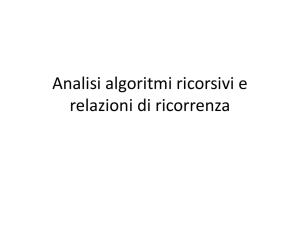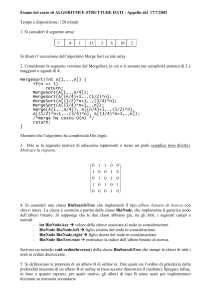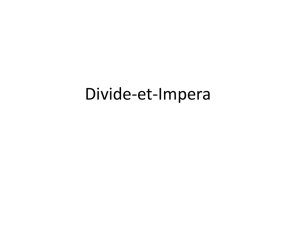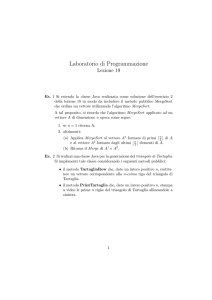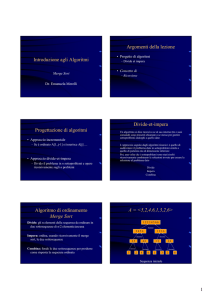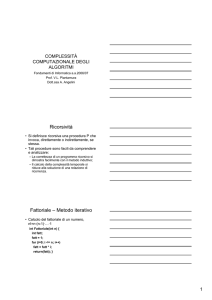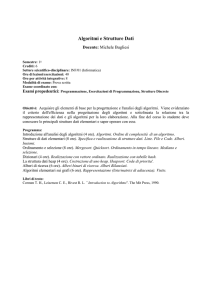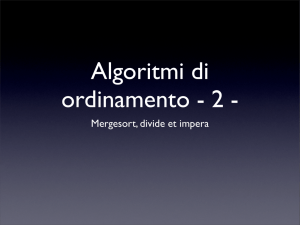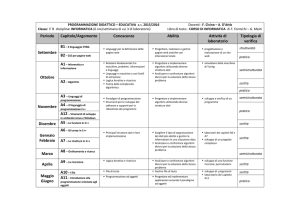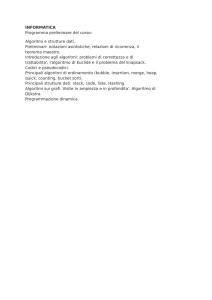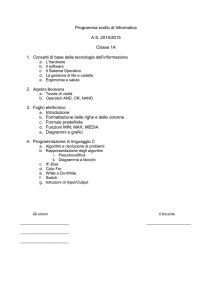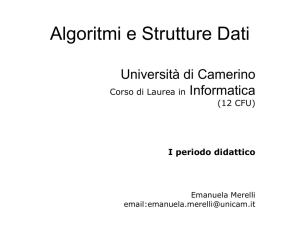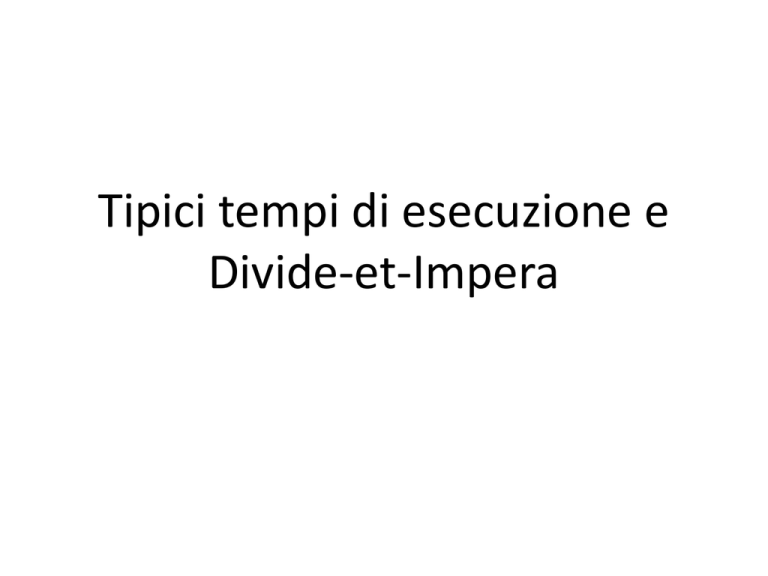
Tipici tempi di esecuzione e
Divide-et-Impera
Linear Time: O(n)
Linear time. Running time is at most a
constant factor times the size of the input.
max a1
for i = 2 to n {
if (ai > max)
max ai
}
Computing the maximum. Compute
maximum of n numbers a1, …, an.
2
Linear Time: O(n)
Merge. Combine two sorted lists A = a1,a2,…,an with
b1,b2,…,bn
B =
into sorted whole.
i = 1, j = 1
while (both lists are nonempty) {
if (ai bj) append ai to output list and increment i
else(ai bj)append bj to output list and increment j
}
append remainder of nonempty list to output list
Claim. Merging two lists of size n takes O(n) time.
Pf. 3After each comparison, the length of output list increases by 1.
Quadratic Time:
2
O(n )
Quadratic time. Enumerate all pairs of elements.
Closest pair of points. Given a list of n points in the plane
(x1, y1), …, (xn, yn), find the pair that is closest.
O(n2) solution. Try all pairs of points.
min (x1 - x2
+ (y1 - y2
for i = 1 to n {
for j = i+1 to n {
d (xi - xj)2 + (yi - yj)2
if (d < min)
min d
}
}
)2
4
)2
don't need to
take square roots
Cubic Time:
3
O(n )
Cubic time. Enumerate all triples of elements.
Set disjointness. Given n sets S1, …, Sn each of which is a subset of
1, 2, …, n, is there some pair of these which are disjoint?
foreach set Si {
foreach other set Sj {
foreach element p of Si {
determine whether p also belongs to Sj
}
if (no element of Si belongs to Sj)
report that Si and Sj are disjoint
}
}
O(n3) solution. For each pairs of sets, determine if they are disjoint.
5
Polynomial Time:
k
O(n )
Time
Independent set of size k. Given a graph, are there k nodes such
that no two are joined by an edge?
k is a constant
O(nk) solution. Enumerate all subsets of k nodes.
foreach subset S of k nodes {
check whether S in an
independent set
if (S is an independent set)
report S is an independent
set
}
}
6
Check whether S is an independent set = O(k2).
k
Number of k element subsets = n n (n 1) (n 2) (n k 1) n
k!
2
k
k
k k (k 1) (k 2) (2) (1)
O(k n / k!) = O(n ).
Exponential Time
Independent set. Given a graph, what is maximum size
of an independent set?
O(n2 2n) solution. Enumerate all subsets.
S*
foreach subset S of nodes {
check whether S in an independent set
if (S is largest independent set seen so far)
update S* S
}
}
Note the differences with Independent set of size k.
7
Sub-linear Time: O(log n)
Tempo lineare: esamina tutto l’input eseguendo
operazioni di tempo costante ad ogni passo
Tempo sub-lineare: Non è necessario esaminare
tutto l’input!
Esempio. Ricerca binaria: ricerca di un elemento in
un array ordinato (per esempio un vocabolario)
8
O(n log n) Time
Molto comune perché
• E’ il running time di algoritmi divide-and-conquer che
dividono l’input in due parti, le risolvono ricorsivamente e
poi combinano le soluzioni in tempo lineare.
• Running time di algoritmi di ordinamento.
Mergesort and Heapsort hanno usano O(n log n)
confronti.
• Molti algoritmi usano l’ordinamento come passo più costoso.
Per esempio molti algoritmi basati sulla tecnica greedy
11
Divide-and-Conquer
“Divide et impera”
Giulio Cesare
Divide-and-conquer.
– Break up problem into several parts.
– Solve each part recursively.
– Combine solutions to sub-problems into overall
solution.
Examples: Binary Search, Mergesort, …..
12
Ricerca binaria (versione D-et-I)
Divide – et - Impera
– Dividi il problema in sottoproblemi
– Risolvi ogni sottoproblema ricorsivamente
– Combina le soluzioni ai sottoproblemi per
ottenere la soluzione al problema
Ricerca binaria:
- Dividi l’array a metà (determinando l’elemento di mezzo)
- Risolvi ricorsivamente sulla metà di destra o di sinistra o su nessuna
(a secondo del confronto con l’elemento di mezzo)
- Niente
Sorting
Sorting. Given n elements, rearrange in ascending
order.
Obvious sorting applications.
List files in a directory.
Organize an MP3 library.
List names in a phone book.
Display Google PageRank
results.
Problems become easier once
sorted.
Find the median.
Find the closest pair.
Binary search in a database.
Identify statistical outliers.
Find duplicates in a mailing.
list
14
Non-obvious sorting applications.
Data compression.
Computer graphics.
Interval scheduling.
Computational biology.
Minimum spanning tree.
Supply chain management.
Simulate a system of particles.
Book recommendations on
Amazon.
Load balancing on a parallel
computer.
...
Mergesort
Mergesort.
– Divide array into two halves.
– Recursively sort each half.
– Merge two halves to make sorted whole.
Jon von Neumann (1945)
A
A
L
A
15
L
G
G
A
G
O
L
G
O
I
R
O
H
R
I
R
I
T
T
H
L
M
H
H
I
O
M
M
M
R
S
S
S
S
T
T
divide O(1)
sort
2T(n/2)
merge O(n)
Mergesort
Mergesort su una sequenza S con n elementi
consiste di tre passi:
1. Divide: separa S in due sequenze S1 e S2,
ognuna di circa n/2 elementi;
2. Ricorsione: ricorsivamente ordina S1 e S2
3. Conquer (impera): unisci S1 e S2 in
un’unica sequenza ordinata
Mergesort
Supponendo che:
la sequenza sia data come un array A*p, … ,r+ con n= r-p+1 elementi,
MERGE(A, p, q,r) «fonda» le sequenze A*p,…, q+ e A*q+1, …, r+
Esempio di esecuzione di
MergeSort
• Divide
7 2 9 43 8 6 1
77
22
99
44
33
88
66
11
Esempio di esecuzione (cont.)
• Chiamata ricorsiva, divide
7 2 9 43 8 6 1
7 29 4
77
22
99
3 8 6 1
44
33
88
66
11
Chiamata ricorsiva, divide
7 2 9 43 8 6 1
7 29 4
72
77
22
3 8 6 1
9 4
99
44
33
88
66
11
• Chiamata ricorsiva: caso base
7 2 9 43 8 6 1
7 29 4
72
77
22
3 8 6 1
9 4
99
44
33
88
66
11
• Chiamata ricorsiva: caso base
7 2 9 43 8 6 1
7 29 4
72
77
22
3 8 6 1
9 4
99
44
33
88
66
11
• Merge
7 2 9 43 8 6 1
7 29 4
722 7
77
22
3 8 6 1
9 4
99
44
33
88
66
11
• Chiamata ricorsiva, …, caso base, merge
7 2 9 43 8 6 1
7 29 4
722 7
77
22
3 8 6 1
9 4 4 9
99
44
33
88
66
11
• Merge
7 2 9 43 8 6 1
7 29 4 2 4 7 9
722 7
77
22
3 8 6 1
9 4 4 9
99
44
33
88
66
11
• Chiamata ricorsiva, …, merge, merge
7 2 9 43 8 6 1
7 29 4 2 4 7 9
722 7
77
22
9 4 4 9
99
44
3 8 6 1 1 3 6 8
3 8 3 8
33
88
6 1 1 6
66
11
• Ultimo Merge
7 2 9 43 8 6 1 1 2 3 4 6 7 8 9
7 29 4 2 4 7 9
722 7
77
22
9 4 4 9
99
44
3 8 6 1 1 3 6 8
3 8 3 8
33
88
6 1 1 6
66
11
Tempo di esecuzione di Mergesort
Come si calcola il tempo di esecuzione di un algoritmo ricorsivo?
E in particolare:
Come si calcola il tempo di esecuzione di un algoritmo Divide et Impera?
A Recurrence Relation for Mergesort
Def. T(n) = number of comparisons to mergesort an input of
size n.
Mergesort recurrence.
if n 1
(1)
T( n) T n / 2 T n / 2 (n) otherwise
merging
solve left half
solve right half
Solution. T(n) = O(n log n).
2
Assorted proofs. We will describe several ways to prove this
recurrence. Initially we assume n is a power of 2 and replace
with =.
29
A Recurrence Relation for Binary Search
Def. T(n) = number of comparisons to run Binary Search
on an input of size n.
Binary Search recurrence.
if n 1
(1)
T( n) T n / 2 (1) otherwise
solve
left or right half comparison
Solution. T(n) = O(log n) (constant in the best case).
2
30
Algoritmi ricorsivi
Schema di un algoritmo ricorsivo (su un’istanza I ):
ALGO (I )
If «caso base» then «esegui certe operazioni»
else «esegui delle operazioni fra le quali
ALGO(I 1), … , ALGO(I k) »
Relazioni di ricorrenza per algoritmi ricorsivi
Relazioni di ricorrenza per algoritmi
Divide-et-Impera
• Dividi il problema di taglia n in a sotto-problemi
di taglia n/b
• Ricorsione sui sottoproblemi
• Combinazione delle soluzioni
T(n)= tempo di esecuzione su input di taglia n
T(n)= D(n) + a T(n/b) + C(n)
Nelle prossime lezioni….
Impareremo dei metodi per risolvere le
relazioni di ricorrenza

